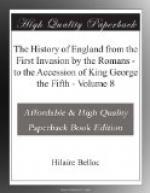3. We know not how far this second massacre was originated or encouraged by Cromwell. It is well known that in the sack of towns it is not always in the power of the commander to restrain the fury of the assailants, who abuse the license of victory to gratify the most brutal of their passions. But here we have no reason to suppose that Cromwell made any effort to save the lives of the unarmed and the innocent. Both the commander and his men had a common religious duty to perform. They were come, in his own language, “to ask an account of the innocent blood which had been shed,”—to “do execution on the enemies of God’s cause.” Hence, in the case of a resisting city, they included the old man, the female, and the child in the same category with the armed combatant, and consigned all to the same fate.
4. Of the proceedings of the victors during that night we are ignorant; but it does not suggest a very favourable notion of their forbearance, that in the following morning the great church of St. Peter’s was filled with crowds of townspeople of both sexes, and of every age and condition. The majority of the women and children sought protection within the body of the church; a select party of females, belonging to the first families in the town, procured access to the crypts under the choir, which seemed to offer more favourable chances of concealment and safety. But the sacred edifice afforded no asylum to either. The carnage began within the church at an early hour; and, when it was completed, the bloodhounds tracked their prey into the vaults beneath the pavement. Among the men who thus descended into these subterranean recesses, was Thomas Wood, at that time a subaltern, afterwards a captain in Ingoldsby’s regiment. He found there, according to his own narrative, “the flower and choicest of the women and ladies belonging to the town, amongst whom a most handsome virgin, arrayed in costly and gorgeous apparel, kneeled down to him with tears and prayers to save her life; and being strucken with a profound pitie, he took her under his arme, and went with her out of the church with intentions to put her over the works to shift for herself; but a soldier perceiving his intention, he ran his sword up her belly or fundament. Whereupon Mr. Wood, seeing her gasping, took away her money, jewels, &c., and flung her down over the works.” (See the Life of Anthony a Wood, p. xx., in the edition by Bliss, of 1813. Thomas was the brother of Anthony, the Oxford historian.) “He told them also that 3,000 at least, besides some women and children, were, after the assailants had taken part, and afterwards all the towne, put to the sword on the 11th and 12th of September, 1649. He told them that when they were to make their way up to the lofts and galleries of the church, and up to the tower, where the enemy had fled, each of the assailants would take up a child, and use as a buckler of defence, when they ascended the steps, to keep themselves from being shot or brained.”—Wood, ibid. These anecdotes, from the mouth of one who was an eyewitness of, probably a participator in, the horrors of that day, will enable the reader to form an adequate notion of the thirst for blood which stimulated the soldiery, and of the cruelties which they exercised on their defenceless victims.




